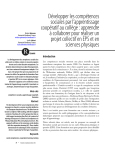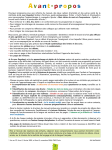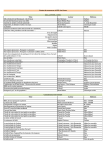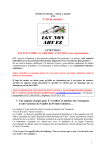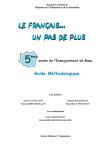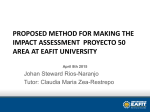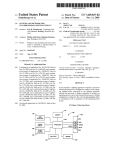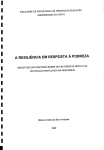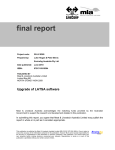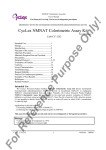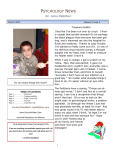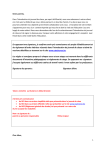Download Developing the emotional competence of teachers and pupils in
Transcript
Developing the emotional competence of teachers and pupils in school contexts Pérez-Escoda, N. 1, Filella, G2., Alegre, A. 3 & Bisquerra, R. 1 1 Department of Methods of Research and Diagnosis in Education, University of Barcelona, Barcelona, Spain 2 Department of Pedagogy and Psychology, University of Lleida, Lleida, Spain 3 Early Childhood and Elementary Education Department, East Stroudsburg University, East Stroudsburg, Pennsylvania, USA Spain / USA Correspondence: Núria Pérez-Escoda.Universitat de Barcelona. Passeig Vall d’Hebrón 171, Llevant 08035 Barcelona (Spain). E-mail: [email protected] © Education & Psychology I+D+i and Editorial EOS (Spain) Nuria Pérez-Escoda et al. Abstract Introduction. This paper describes the evaluation of two training programmes, one targeted at teachers and the other at pupils, the aim of both being to improve personal and social wellbeing through the development of emotional competence (emotional awareness, emotional regulation, emotional autonomy, social competence and life competencies). Method. Participants were 92 teachers and 423 children aged 6-12 years from various primary schools. A quasi-experimental pre-test/post-test design with control group was used to evaluate the efficacy of the two training programmes, with different instruments being applied to measure the evolution of emotional competence and its five dimensions. Results. The results showed a significant improvement in the emotional competence of participants at the end of the intervention, together with a better relational climate in schools. Discussion and Conclusion. They also corroborate current expert opinion that emotional competencies such as emotional awareness, emotion regulation, emotional autonomy, social competence, and life and well being competencies can be taught and learnt. Keywords: Emotional education, emotional intelligence, social and emotional learning, programme evaluation, primary school, assessment of emotional competence. Received: 07/25/12 - 1184 - Initial acceptance: 08/30/12 Final acceptance: 11/08/12 Electronic Journal of Research in Educational Psychology, 10(3), pp: 1183-1208. ISSN: 1696-2095. 2012, no. 28 Developing the emotional competence of teachers and pupils in school contexts Desarrollo de la competencia emocional de maestros y alumnos en contextos escolares Resumen Introducción. En este trabajo se presenta la evaluación de dos programas de formación, uno dirigido a profesores y otro a alumnos con el objetivo de mejorar el bienestar personal y social mediante el desarrollo de la competencia emocional (conciencia emocional, regulación emocional, autonomía emocional, competencia social y competencias para la vida). Método. Han participado en la experiencia 92 profesores y 423 niños de 6 a 12 años de diversos centros de educación primaria. Se ha utilizado un diseño cuasiexperimental pretest-postest con grupo control para evaluar la eficacia de cada uno de los programas de formación. Para ello se han aplicado diferentes instrumentos para medir la evolución la competencia emocional y sus cinco dimensiones. Resultados.La investigación demuestra una mejora significativa de la competencia emocional de los participantes al final de la intervención, junto a un mejor clima de relación en las escuelas. Discusión y Conclusión.Se corrobora la opinión de los expertos en el tema quienes afirman que las competencias emocionales tales como: la conciencia emocional, la regulación emocional, la autonomía emocional, las competencias sociales, y las habilidades de vida y bienestar pueden enseñarse y aprenderse. Palabras Clave: Educación Emocional, inteligencia emocional, aprendizaje social y emocional, evaluación de programas, escuela primaria, evaluación de la competencia emocional. Recibido: 25/07/12 Aceptación inicial: 30/08/12 Aceptación final: 08/11/12 Electronic Journal of Research in Educational Psychology, 10(3), pp: 1183-1208. ISSN: 1696-2095. 2012, no. 28 - 1185 - Nuria Pérez-Escoda et al. Introduction There are good reasons to consider emotional education as part of the zeitgeist characterizing the beginning of the twenty-first century. Fernández Berrocal and Ruiz Aranda (2008) consider that nowadays is completely necessary to educate the emotional intelligence of children. This idea of emotional education now has strong theoretical underpinnings which are undergoing constant revision and update (Bechara, Tranel, & Damasio, 2000; Goleman, 1995; Mayer, Caruso, & Salovey, 2001; Bisquerra, 2000, 2009; Gardner 1993; Cherniss, 2000; Hedlund & Sternberg, 2000, among many others). Experts in the field agree that there are certain emotional competencies which can be learnt, and that there is a need to integrate them within the early and continuous learning of everybody (Mayer, Caruso, & Salovey, 2002; Salovey et al, 2000; Collaborative for Academic, Social and Emotional Learning, 2003; Petrides, Frederickson, & Furnham, 2004; Saarni, 2000; Sroufe, 2000). These competencies prove enormously useful when facing a wide variety of everyday situations (Humphrey, 2010; Saarni, 2000). A number of reviews have investigated the outcomes of various emotional education programmes (Catalano et al, 2002; Greenberg, Weissenberg, O’Brien, Zins, Fredericks, Resnik & Elias, 2003; Clouder et al., 2008; Di Fabio et al, 2011), demonstrating their positive effects on children in a range of contexts (from kindergarten to high-school, and in urban, suburban and rural settings). Specifically, the meta-analysis by Greenberg et al. (2003), who analysed 300 social and emotional learning programmes, showed that these kinds of programmes lead to significant improvements in children’s school performance. Also, Nelis et al (2009) found that young adults who participated in an intensive emotional training course improved their levels of emotional intelligence. This improvement was sustained six months later. In their study, Nelis et al (2009) concluded that the vast majority of emotional intelligence training programs suffer from three kinds of design problems: 1) most are not based on a solid theoretical model, 2) they only target certain dimensions of emotional intelligence, and 3) they do not use control groups. In light of the above, there is a need for a research study in which the emotional education programme being investigated is based on a solid theoretical model, addresses a compre- - 1186 - Electronic Journal of Research in Educational Psychology, 10(3), pp: 1183-1208. ISSN: 1696-2095. 2012, no. 28 Developing the emotional competence of teachers and pupils in school contexts hensive group of emotional competencies, and uses an experimental design with control group. The present study seeks to investigate the effectiveness of an emotional education program that addresses these three design issues: it is based in a solid theoretical model (Bisquerra & Pérez, 2007); it addresses a comprehensive group of emotional competencies, and uses an experimental and a control group to find evidence of significant effects. The Bisquerra and Perez’s (2007) theoretical model of emotional competence proposes that the emotional competencies can be grouped into five big dimensions: emotional awareness, emotional regulation, personal autonomy, social competence, and life competencies and well-being. Emotional awareness integrates the capacity to be aware of one´s own emotions, and the ability to grasp the emotional climate in any specific context. Emotional regulation refers to the capacity to use the emotions appropriately. It requires being aware of the relation between emotion, cognition, and behaviour, and to have efficient coping strategies, and capacity to self-generate positive emotions. Personal autonomy includes a group of characteristics related to the self-management of emotions such as: self-esteem, life positive attitude, responsibility, capacity to critically analyze social rules, capacity to look for help and resources when needed, and self-efficacy beliefs. Social competence refers to the capacity to establish positive relationships with other people. It requires the mastering of basic social abilities, effective communication, respect for others, pro-social assertive behaviour. Life competencies and well-being refers to the capacity to display responsible and appropriate behaviours to solve personal, family, professional, and social problems aimed towards the improvement of the person’s and the society’s well-being. The Bisquerra and Perez model can be considered a trait EI model because it incorporates both cognitive and personality dimensions. Compared to typical ability models of emotional intelligence (e.g. Mayer and Salovey, 2007), it has the advantage of being more comprehensive. Compared to other trait EI models (Petrides, Frederick son & Furnham, 2004), it has the advantage of being more hierarchically structured thereby facilitating the subsequent development of intervention programmes (Bisquerra & Perez, 2007). The intervention programme developed, based on Bisquerra and Perez’s (2007) model of emotional competence, provides specific training sections for each one of the five emotional competencies included in the model. For emotional awareness, the program helps participants to widen their emotional vocabulary, and to learn to recognize their own emotions. Electronic Journal of Research in Educational Psychology, 10(3), pp: 1183-1208. ISSN: 1696-2095. 2012, no. 28 - 1187 - Nuria Pérez-Escoda et al. To train in emotional regulation, participants learn relaxation techniques. For personal autonomy, they learn to recognize their own qualities and use them to increase their autonomy. To develop social competence, participants learn to recognize the emotions of others, and to express their own emotions in socially appropriate ways. They also learn conflict resolution techniques, assertiveness and empathy. In terms of life competencies and well-being, participants learn to be critically reflective, and to keep a balance between their personal interests and the requirements of the environment. The training programme uses different skill building techniques to integrate theory in an experiential and participative way, through group dynamics, reflection, debates and role-play exercises. The aim of the study, therefore, is to investigate the efficacy of an emotional education program that is based in a solid theoretical model, is comprehensive in the emotional competencies that addresses, and that uses a control group as a means of evaluating results. The program is divided in two subprograms. The first subprogramme was imparted by the researchers and directed towards the emotional education of the teachers in various schools from two Spanish cities. The second subprogramme was imparted by the trained teachers and directed towards their students. As a consequence, two studies were conducted: one to evaluate the efficacy of the emotional education programme for teachers (Study 1), and the other to evaluate the effectiveness of the equivalent programme which teachers applied to their pupils (Study 2). Study 1 This study analysed the effect of the Emotional Education Programme for Teachers as regards the development of emotional competence among participants. Previous research has shown that teachers understand the need to improve their own social and emotional competencies as a prerequisite to reinforcing and enhancing the skills and competencies of their students (Triliva & Poulou, 2006). Therefore, our intervention programme started with the training of the teachers. In line with the model of Bisquerra and Pérez (2007) the focus was on both general emotional competence and each of its five dimensions: emotional awareness, emotional regulation, emotional autonomy, social competence, and life competencies and well-being. - 1188 - Electronic Journal of Research in Educational Psychology, 10(3), pp: 1183-1208. ISSN: 1696-2095. 2012, no. 28 Developing the emotional competence of teachers and pupils in school contexts The program consists of 30 hours of training, and it was implemented in sessions of one hour a week, for 30 weeks, in a period of nine months. The training sessions took place in the schools where the teachers work. Six hours of training were allocated to each emotional competency described above. The teachers were trained by the authors of the study themselves. To ascertain the efficacy of the programme, three kinds of evidence are necessary. First, it is important to know if the programme has had any effect on the participants’ emotional competence. Second, if the programme has been effective, it should result in positive outcomes for the participants. Specifically, any improvement in teachers’ emotional competence should be reflected in their ability to better deal with the challenges of the job and experiment less stress. In this sense, several studies (Brackett et al, 2010; Extremera, FernándezBerrocal & Durán, 2003) have shown that when teachers enjoy high levels of emotional intelligence they experience fewer negative thoughts and less burnout. Finally, a school where teachers have improved their emotional competence, and reduced their levels of stress should experience a more harmonious school climate. Hypotheses of Study 1 We expected that compared to the control group, teachers participating in the emotional education programme would experience the following: 1) an improvement in their total emotional competence and in each one of its dimensions: emotional awareness, emotional regulation, emotional autonomy, social competence, and life competencies and wellbeing; 2) a reduction in stress levels; and 3) an improvement in the institutional climate. Method of Study 1 Participants The sample comprised 92 teachers, of whom 62% were assigned to the EG. Participants were recruited through intentional sampling of homogenous subgroups. Teachers in the EG were drawn from three state-run primary schools, while the control group (CG) was recruited from a further five such schools. These schools were located in medium-low SES Electronic Journal of Research in Educational Psychology, 10(3), pp: 1183-1208. ISSN: 1696-2095. 2012, no. 28 - 1189 - Nuria Pérez-Escoda et al. neighbourhoods. All teachers had at least a bachelor’s degree, and their mean age was 42. Eighty-eight per cent of participants were female, which reflects the typical profile of the primary school teacher in Spain. Procedure Teachers in the experimental group (EG) took part in the above described emotional education programme. A quasi-experimental pre-test/post-test design with control group was used to evaluate the efficacy of the training programme. All instruments were administered to teachers in both groups. The interval between pre-test and post-test assessment was nine months. Measures Emotional Competence. Emotional competence was measured using the Emotional Development Inventory for Adults (CDE-A in the original Spanish), developed by the Research in Psycho-educational Guidance Group (GROP) of the University of Barcelona. This is a self-report instrument based on the theoretical model of emotional education developed by Bisquerra and Pérez (2007). It comprises 48 items (e.g. “I find difficult to talk with my friends about my feelings”) each of which is scored on an 11-point Likert scale from 0 to 10, and provides both a global score and one for each of the model’s five dimensions. The scale was validated by a panel of 11 experts who paired each item to the corresponding subscale according to the goal of the scale and the theoretical model. All items obtained above 80% agreement among all experts for each scale (Pérez-Escoda, et al, 2010). The authors submitted the scale to an exploratory factor analysis using Varimax rotation. Analysis of eigenvalues, and scree-plot revealed five factors that were termed emotional awareness, emotional regulation, emotional autonomy, social competence, and life competencies and well-being, as they confirmed the theoretical model. The five factors explained 50% of the variance. The authors report reliability measures (Cronbach’s alpha) of .92 for the whole scale and above .69 for each of the five dimensions. In the present study the Cronbach’s alpha values were .91 for the whole scale, .67 for emotional awareness, .79 for emotional regulation, .61 for emotional autonomy, .68 for social competence and .72 for life competencies and well-being. - 1190 - Electronic Journal of Research in Educational Psychology, 10(3), pp: 1183-1208. ISSN: 1696-2095. 2012, no. 28 Developing the emotional competence of teachers and pupils in school contexts Level of Stress. An ad hoc five-item scale was developed to measure the participants’ level of stress. As perceived stress depends on numerous factors this scale was based on the dimensions proposed by Novak (1991, 2008): personal, interpersonal and contextual (health, employment and family situation). Participants scored from 0 (very bad) to 10 (excellent) how satisfied they were with each dimension. It comprises 5 items. The internal consistency of the scale (measured by Cronbach’s alpha) was .57. Institutional Climate. This aspect focused specifically on the relational climate in the school: relationships among teachers, among pupils, and with the pupils’ families. Participants scored from 0 (very bad) to 10 (excellent) how good the relational climate is in each level of the school. One institutional climate coefficient was computed. The scale used to assess this aspect had an internal consistency (measured by Cronbach’s alpha) of .63. Data Analysis Due to the normal distribution of errors and the lineal relation between dependent and independent variables, emotional competence, institutional climate, and levels of stress data were submitted to a General Linear Model analysis. For each competency, General Linear Model for repeated measures was applied. The intrasubjects variables were the phases, and the variable intersubjects the group. Because the factors were only of two categories, we did not perform ad hoc contrast analyses. The link function was used as identity function, the independent variables were considered factors, and the dependent variable was taken as continuous. This analysis was preferred to other non global types of analyses because it allowed us to respect the levels of significance established “a priori”. Results of Study 1 Descriptives Table 1 shows the descriptive statistics for each factor of the CDE-A, and each variable. Electronic Journal of Research in Educational Psychology, 10(3), pp: 1183-1208. ISSN: 1696-2095. 2012, no. 28 - 1191 - Nuria Pérez-Escoda et al. Table 1. Descriptive statistics Pre-test EG CG Post-test Mean SD Mean SD Emotional awareness 7.05 (1.06) 7.27 (1.19) Emotional regulation 5.28 (1.10) 5.86 (1.36) Emotional autonomy 6.05 (1.02) 6.44 (1.14) Social competence 5.68 (1.01) 5.87 (1.37) Life competencies and well-being 7.04 (.97) 7.35 (1.20) Total 6.12 (.81) 6.49 (1.10) Levels of stress 16.68 (4.74) 14.39 (3.55) Institutional climate 25.00 (4.75) 27.73 (3.56) Emotional awareness 7.28 (1.17) 7.15 (1.24) Emotional regulation 5.73 (1.44) 5.69 (1.38) Emotional autonomy 6.08 (1.22) 6.09 (1.28) Social competence 5.59 (1.37) 5.70 (1.38) Life competencies and well-being 6.89 (1.45) 6.95 (1.48) Total 6.24 (1.14) 6.24 (1.19) Levels of stress 16.51 (4.88) 16.61 (4.94) Institutional climate 25.54 (3.93) 25.87 (3.81) Note: EG= Experimental Grup, CG= Control Group. N for EG= 57, N for CG = 35. Program effects Application of the general linear model with 1.11 degrees of freedom for the emotional competence variables, and 1.75 degrees of freedom for the levels of stress and institutional climate variables can be seen in Table 2. Differences between the pre-test and post-test stages, between the EG and the CG and as regards the stage*group interaction are reported. There were no significant differences between the pre-test and post-test stages, nor between the EG and the CG for any of the five emotional competencies or for the total emotional competence coefficient. However, there were significant stage*group interactions for emotional regulation, social competence and total emotional competence, with only the intervention group (EG) showing a significant increase in the three dimensions. Additionally, there - 1192 - Electronic Journal of Research in Educational Psychology, 10(3), pp: 1183-1208. ISSN: 1696-2095. 2012, no. 28 Developing the emotional competence of teachers and pupils in school contexts were significant stage*group interactions, for level of stress and for perception of institutional climate. In both cases, only the EG reported significant improvements. Table 2. Overall General Linear Model results Emotional Factor F P Stage (pre-post) .016 .9 Group (EG-CG) .002 .961 Stage*Group 2.435 .122 Stage (pre-post) 2.771 .1 Group (EG-CG) .603 .439 Stage*Group 25.773 .000 Stage (pre-post) 1.970 .163 Group (EG-CG) .011 .921 Stage*Group 2.369 .131 Social Comp- Stage (pre-post) .107 .750 tence Group (EG-CG) .540 .464 Stage*Group 5.288 .023 Life Compe- Stage (pre-post) .539 .464 tence Group (EG-CG) .880 .350 Stage*Group 3.595 .061 Total Emo- Stage (pre-post) .196 .659 tional Compe- Group (EG-CG) .026 .872 tence Stage*Group 10.074 .000 Levels of stress Stage (pre-post) .078 .781 Group (EG-CG) .128 .721 Stage*Group 9.231 .000 Institutional Stage (pre-post) 9.879 .000 climate Group (EG-CG) .146 .703 13.373 .000 competence E. Awareness E. Regualtion E. Autonomy Stage*Group Note. df for emotional competencies = 1.11. df for levels of stress and institutional climate = 1.75 Electronic Journal of Research in Educational Psychology, 10(3), pp: 1183-1208. ISSN: 1696-2095. 2012, no. 28 - 1193 - Nuria Pérez-Escoda et al. Discussion of Study 1 The results presented above show that the emotional education programme for teachers led to significant improvements in the development of certain emotional competencies among participants. However, the intervention did not develop all five dimensions of emotional competence to the same extent. The most notable improvements experienced by the teachers were those in emotional regulation and social competence. These findings are given further weight by the fact that teachers in the CG, who did not participate in the programme, did not experience statistically significant changes in their total competence or on any of the five dimensions studied. It can be concluded, therefore, that the emotional education programme was at least partially effective. Furthermore, teachers who took part in the programme also reported improved perceptions regarding the institutional climate, as well as a significant reduction in perceived stress. This confirms that the intervention is an effective resource that can help to optimize interpersonal relationships in schools, having a positive impact on the quality of life of those who work there. Study 2 This study analysed the effectiveness of the Emotional Education Programme for the Development of Emotional Competence in Primary School Children. The programme was administered by the teachers who received the training in Study 1. The contents of this training programme were essentially the same as those used in the training programme for teachers. Each teacher adapted the content and activities to the needs of each specific group of children. The training was offered in the schools and during the normal timetable, there being a one-hour session once a week for twenty weeks. Hypothesis of Study 2 We expected that compared to the control group, children who participated in the emotional education programme (the experimental group) would experience an improvement in their total emotional competency and in each one of the five sub-competencies: emotional - 1194 - Electronic Journal of Research in Educational Psychology, 10(3), pp: 1183-1208. ISSN: 1696-2095. 2012, no. 28 Developing the emotional competence of teachers and pupils in school contexts awareness, emotional regulation, emotional autonomy, social competence, and life competencies and well-being. Method of Study 2 Participants Participants were 423 pupils aged 6-12 years, 51.3% of whom were boys. All the children attended state-run schools in medium-low SES neighbourhoods. The experimental group (EG) included 223 pupils, with the remaining 200 constituting the control group (CG). Pupils’ participation was dependent on the teachers’ voluntary application of the training they had received in Study 1. Procedure The emotional education programme for children comprises 20 activities that are distributed into thematic blocks corresponding to the five dimensions of the theoretical model. In the EG one activity was applied weekly in the context of the standard teaching plan. The activity sessions were always ran by the children’s usual teacher, and the pupils were encouraged to get involved through both individual and group work, this being the key strategy aimed at developing their emotional competence. The effects of the programme were studied by means of a quasi-experimental pre-test/post-test design with a control group. The interval between the pre-test and post-test assessments was nine months. Instruments In order to evaluate the development of the competencies proposed by the programme, two different instruments were used in accordance with the children’s age. a) Emotional Competence Observation Instrument Due to the lack of available scales for measuring the emotional development of pri- mary age children (6-8 years) it was necessary to develop an ad hoc observation instrument. This was based on the above-mentioned theoretical model of Bisquerra and Pérez (2007) and Electronic Journal of Research in Educational Psychology, 10(3), pp: 1183-1208. ISSN: 1696-2095. 2012, no. 28 - 1195 - Nuria Pérez-Escoda et al. enabled us to estimate the children’s general emotional competence and that on each of its five dimensions. The observation instrument used has 79 items, of which 25 refer to behaviours through which children show their emotional awareness (e.g. identifies sadness in others), 8 refer to their emotional regulation (e.g. can ask others for help), 12 refer to emotional autonomy (e.g. identifies his or her limitations), 27 refer to social competence (e.g. can defend his or her rights), and 7 refer to life competencies and well-being (e.g. can maintain a positive attitude towards changes). The evaluation of each child’s emotional competence was based on his/her teacher’s perceptions. Prior to applying the observation scale, it was piloted and validated by expert judges. Its internal consistency according to Cronbach’s alpha was .78 for the total scale and above .75 for each subscale. The teacher rated each scale item between 0 and 10 (0 = never, 10 = almost always). b) The BarOn Emotional Quotient Inventory: Youth Version (EQ-i:YV); Spanish version (BarOn-ICE:NA), abridged and adapted by Ugarriza and Pajares (2004) The effect of the programme on children from primary (age 9-12) was evaluated using this instrument, which has previously been used with this age range by other authors, and has demonstrated reliability and validity (Sotil, et al, 2005; Ugarriza & Pajares, 2005). The short version of the inventory comprises 30 items and provides a total emotional quotient and one for each of the following scales: Interpersonal, Intrapersonal, Adaptability, and Stress Management (Bar-On & Parker, 2000). The Interpersonal scale evaluates the extent to which social relationships are satisfactory, and includes skills such as empathy and listening, and understanding and appreciating the feelings of others. The Intrapersonal scale measures the capacity to understand one’s own emotions and to express feelings and needs. The Adaptability scale evaluates the degree of flexibility and realism when coping with change and solving problems. The Stress Management scale measures the capacity to regulate impulsivity, to remain calm and to work well under pressure. Data Analysis Again, due to the normal distribution of errors and the lineal relation between dependent and independent variables, data were submitted to a General Linear Model analysis. - 1196 - Electronic Journal of Research in Educational Psychology, 10(3), pp: 1183-1208. ISSN: 1696-2095. 2012, no. 28 Developing the emotional competence of teachers and pupils in school contexts Results of Study 2 a) Children aged 6-8 years The normality of the sample was confirmed with the Kolmogorov-Smirnov test, which was applied to the global scale score and to scores on the five dimensions (p>.05 in all cases). On the basis of these results, the general linear model was then applied. Table 3 shows the descriptive statistics obtained for each of the five dimensions and for total emotional development. Program effects Application of the general linear model with 1 degree of freedom for the emotional competence variables yielded the following results: Emotional awareness. There was a significant increase (f=58.799, p<.01) in scores after the intervention (post-test stage) for both the EG and the CG, as well as a significant between-groups effect (f=36.27, p<.01). The main finding was a significant group*stage effect, showing that only the EG improved significantly after the intervention (f =80.00, p<.01). Emotional regulation. There was a significant post-intervention increase (f =5.20, p<.05) in both the EG and the CG, although the significance level was higher (f =15.12, p<.01) in the intervention group. However, the main result was the significant group*stage interaction (f = 14.97, p<.01), with only the intervention group showing significantly better emotional regulation after the programme. Emotional autonomy. There was a significant post-intervention increase (f=16.32, p<.01) in both the EG and the CG, as well as a significant between-groups effect (f=.24, p<.01) in favour of the EG. The main finding was a significant group*stage interaction, showing that only the EG improved significantly after the intervention (f=17.67, p<.01). Social competence. Social competence increased significantly after the intervention (f=16.26, p<.01), and there was also a significant between-groups effect (f=4.81, p=.03). Electronic Journal of Research in Educational Psychology, 10(3), pp: 1183-1208. ISSN: 1696-2095. 2012, no. 28 - 1197 - Nuria Pérez-Escoda et al. Once again, the main result was a significant group*stage interaction, with only the EG showing significantly better social competence after the programme (f=27.97, p<.01). Life competencies and well-being. These aspects also improved significantly after the intervention (f=4.09, p<.05). There were no significant differences between the groups (f=.57, p=.45).. However, the main finding was the significant group*stage interaction, with only the EG showing significantly better life competencies and well-being after the intervention (f=4.83 , p=.03). General emotional competence. This was significantly better (f=11.59, p<.01) after the intervention. There were no between-groups differences (f=2.94, p=.93). The main result was the significant group*stage interaction, showing that general scores only improved significantly (f=21.20, p<.01) in the EG (see Figure 1). Figure 1. Post-intervention change in scores for the scale as a whole b) Children aged 9-12 years Table 3 shows the descriptive results for the six factors from the BarOn inventory. - 1198 - Electronic Journal of Research in Educational Psychology, 10(3), pp: 1183-1208. ISSN: 1696-2095. 2012, no. 28 Developing the emotional competence of teachers and pupils in school contexts Table 3. Descriptive statistics for the scale applied to children 6-8 years Pre-test EG CG Post-test Mean SD Mean SD Emotional awareness 5.75 (.79) 7.48 (.32) Emotional regulation 6.47 (1.39) 7.38 (1.04) Emotional autonomy 6.25 (1.12) 7.04 (.35) Social competence 6.57 (.937) 7.71 (.93) Life competencies and well-being 6.17 (1.17) 6.90 (1.29) Total 6.25 (.87) 6.99 (.69) Emotional awareness 5.26 (.82) 5.47 (.78) Emotional regulation 5.96 (.93) 5.7 (1.03) Emotional autonomy 6.71 (.97) 6.71 (.91) Social competence 6.53 (1.28) 6.3 (1.40) Life competencies and well-being 6.75 (1.36) 6.68 (1.38) Total 6.09 (.83) 6.05 (.87) Note: EG= Experimental Grup, CG= Control Group. N for EG= 13, N for CG =1. When applying the general linear model, the repeated-measures analysis of the results obtained for the intrapersonal factor of the EQ-i:YV (Spanish version) showed no significant differences between stages (f=1.05, p>.05), or between groups (f=1.73, p>.05) or. By contrast, there were significant differences between age groups (f=6.57, p<.05). The results also revealed a significant stage*group interaction (f=9.94, p<.01), with scores in the EG increasing while those of the CG decreased. The interpersonal factor showed a significant increase (f=33.81, p<.01) after the intervention. There was also a significant effect according to group (f=.03, p<.01), and age (f=10.97, p<.05). The results revealed a significant stage*group interaction (f=3.09, p<.01), such that scores in the CG decreased while those in the EG increased. Finally, significant improvements were also observed among pupils aged 9-12 years in the EG (f=1.21, p<.05). There was a significant improvement in adaptability (f=119.25, p<.01) after the intervention. However, there was no significant effect between groups. A significant stage*group interaction (f=6.756, p<.01) was observed, such that scores in the CG decreased while those Electronic Journal of Research in Educational Psychology, 10(3), pp: 1183-1208. ISSN: 1696-2095. 2012, no. 28 - 1199 - Nuria Pérez-Escoda et al. in the EG increased. There was also a group*age interaction (f=.58, p= .02), in favour of EG pupils aged 9-12 years. The main result as regards stress management was the significant stage*group interaction, with only the intervention group showing a significant reduction (f=.10, p<.01) in stress levels, whereas there were no significant differences between stages (f=3.59, p=.08) or groups (f=69, p=.72) alone. Emotional intelligence improved significantly (f=1.09, p<.01) after the intervention, and there was also a significant increase in relation to age (f=6.56, p=.03). The main result was the significant stage*group interaction (f=25.52, p<.01), with scores in the CG decreasing while those of the EG increased. Discussion of Study 2 The data obtained from both the observation scale, used to evaluate emotional development in pupils aged 6-8 years, and the BarOn inventory, administered to pupils aged 9-12 years confirm that the observed improvements were due to the intervention. The youngest pupils showed a significant improvement on all the dimensions of emotional competence addressed by the programme. As regards pupils aged 9-12 years the pre-test/post-test comparison of results from the BarOn inventory showed that they improved on four components: intrapersonal, interpersonal, adaptability, and emotional intelligence. However, they did not make significant improvements as regards stress management, although it should be noted that this aspect was not addressed by the programme used here. Future work of this kind should also include an activity related to life competencies so as to address this component. The results of the study provide new evidence in support of the idea that emotional competence can be developed through emotional education programmes. Consequently, educational institutions should seriously consider making such programmes part of their standard practice, as the development of emotional competence favours the personal and social wellbeing of pupils. - 1200 - Electronic Journal of Research in Educational Psychology, 10(3), pp: 1183-1208. ISSN: 1696-2095. 2012, no. 28 Developing the emotional competence of teachers and pupils in school contexts General Discussion The purpose of the two studies presented in this article was to test the impact of an emotional competence training programme used, initially, with teachers, and subsequently with pupils. The programme was based on Bisquerra and Perez’s (2007) model of emotional competence, which views emotional education as a continuous and permanent educational process that strengthens the development of emotional competencies, regarded as an essential element of human development. The goal of such a process is to capacitate the person for life and, thus, increase his or her personal well-being and that of his or her society (Bisquerra, 2000). The programme implemented here provided 30 hours of training for teachers and about 20 hours of training for school children. The aim was to develop teachers’ and pupils’ emotional awareness, emotional regulation, emotional autonomy, social competence, and life competencies and well-being. Both studies showed an improvement in the participants’ emotional competencies, demonstrating that the programme is effective. Teachers in the experimental group improved their emotional competencies, especially as regards their emotional regulation abilities and social competencies. They also reduced their levels of stress. Additionally, the programme resulted in an improvement in the school’s institutional climate. Furthermore, when the teachers then applied the emotional education programme with their pupils, the latter also showed improved emotional competencies. Although, in recent years, other programmes designed to develop emotional competencies have been shown to be effective, Nelis et al. (2009) point out that most of these studies lack a solid theoretical basis and do not use a control group to evaluate the programme’s effectiveness. The programme described here is the first to be based on Bisquerra and Perez’s model of emotional competence, which incorporates competencies whose importance has been demonstrated by other researchers but which other EI models do not include, for example: emotional autonomy (Noom, 2001), learning to flow (Csikszentmihalyi, 1990) and life competencies (Hopson et al., 1987). It should also be noted, as Nelis et al. (2009) point out, that few previous studies of emotional education programmes have used control groups. By using both an experimental and a control group the present study was able to compare the programme’s effects. Catalano et al. (2002) show that the most successful emotional education programmes share three characteristics: they work on skill building, they target not only children them- Electronic Journal of Research in Educational Psychology, 10(3), pp: 1183-1208. ISSN: 1696-2095. 2012, no. 28 - 1201 - Nuria Pérez-Escoda et al. selves but also their environment, and they involve an intervention that lasts for at least nine months. The present study shares all these characteristics. Specifically, the training emphasizes the building of the five emotional competencies included in Bisquerra and Perez’s model (2007), and uses a range of experiential activities, role-play and group dynamics. Furthermore, by first implementing the programme with teachers it seeks to change the school community in a way that also fosters the development of emotional competencies among pupils. One of the ways in which the institutional climate can be improved is that increased emotional competence among teachers reduces their burnout (Brackett, et al, 2010). In the present study this is reflected in the lower levels of stress reported by teachers, and the concomitant improvement in the institutional climate. A final point of note is that the training offered to both teachers and pupils took the form of a long-term intervention (nine months in both cases). Moreover, the second intervention, implemented with children, is able to address their emotional development from primary years 1 to 6 and for periods of nine months each year, thereby ensuring that any gains made are sustainable. As with any piece of evaluation research, the present study has certain limitations. Firstly, some of the measurement tools were specifically designed for this study. Although most of them showed good reliability and were validated by expert judges, the stress scale had a relatively low reliability, which compromises the results obtained with this measure. Nevertheless, this measure did correlate in the expected direction with the measure of institutional climate, thereby supporting its validity. Another limitation is that data were collected through self-report measures or through teachers’ observations, yielding a kind of subjective information that is prone to some degree of bias. However, there are two problems with the use of direct measures of actual emotional abilities: firstly, there are no ability measures for children in the age range investigated here, and secondly, direct ability measures are both expensive and time consuming to administer (Humphrey et al., 2010). A further limitation to note is that we worked with a convenience sample which may not be completely representative. It would therefore be advisable to replicate the study with a larger random sample so as to enable broader generalization of the results. A longitudinal research design would also be needed to investigate the extent to which the outcomes are maintained in the long term. Future research is now required to examine whether the effectiveness of this programme might also extend to important developmental outcomes such as improving children’s school performance, reducing their aggressive behaviour and levels of conflict at - 1202 - Electronic Journal of Research in Educational Psychology, 10(3), pp: 1183-1208. ISSN: 1696-2095. 2012, no. 28 Developing the emotional competence of teachers and pupils in school contexts school, and increasing their general well-being. It would also be important to investigate whether a programme based on the same model and principles could be implemented with similar results in secondary school pupils. Another important objective for future research would be to complement the training offered to teachers and pupils with programmes targeted at parents. Despite the above-mentioned limitations this study confirms that emotional competencies can be improved through a systematic and well-structured intervention that is based on a solid theoretical model, one which is able to build emotional skills and which is targeted not only at pupils but also at school environment. In terms of the evaluation of emotional education programmes it should be noted that this study uses a control group, which is not the case of most previous research of this kind. It has also developed a new observational measure of young children’s emotional competencies, a measure which may prove useful for future studies since young children are known to have difficulties answering self-report questionnaires. Although the twentieth century brought many technological advances this has been accompanied by certain deterioration in our capacity to manage our emotions, and this can be witnessed in many forms: conflicts, violence, anxiety, stress, depression, etc. (Bisquerra, 2000). In the school context one often observes situations of emotional illiteracy, such as: lack of emotional control, impulsive behaviour, poor performance due to stress, bullying, and teacher burnout (Crary, 1998). In this regard, various studies have related bullying and burnout with feelings of anger, low self-esteem, loneliness and other emotional difficulties, in both aggressors and their victims (Mearns & Cain, 2003). This highlights the need to act preventively in the early years of education, as well as in the context of teacher training. PerezGonzález (2008) points out that the emotional education of children is a task for schools, families and communities. This study presents an educational education program for schools that is successful in improving children´s emotional abilities. Acknowledgements This study was supported by Spain’s Ministerio de Ciencia e Innovación, Dirección general de programas y transferencia de conocimiento (SEJ2007-65505/EDUC), as well as a grant from ARCE (Agrupación de Investigación en Ciencias de la Educación) of the Faculty of Pedagogy, University of Barcelona. Electronic Journal of Research in Educational Psychology, 10(3), pp: 1183-1208. ISSN: 1696-2095. 2012, no. 28 - 1203 - Nuria Pérez-Escoda et al. References Bar-On, R., & Parker, J. D. A. (2000). The Bar-On Emotional Quotient Inventory: Youth Version (EQ-i:YV) Technical Manual. Toronto, Canada: Multi-Health Systems. Bechara, A., Tranel, D., & Damasio, A. R. (2000). Poor judgement in spite of high intellect: Neurological evidence for emotional intelligence. In R. Bar-On & J. D. A. Parker (Eds.), The Handbook of Emotional Intelligence: Theory, Development, Assessment, and Application at Home, School, and in the Workplace (pp. 192-214). San Francisco: Jossey-Bass. Benítez, J. L., Fernández, M., Justicia, F., Fernández E., & Justicia A. (2011). Results of the Aprender a Convivir Program for development of social competence and prevention of antisocial behavior in four-year-old children. School Psychology International, 32, 319. Bisquerra, R. (2000). Educación emocional y bienestar. Barcelona: Praxis. Bisquerra, R., & Pérez-Escoda, N. (2007). Las competencias emocionales. Educación XXI, 10, 61-82. Bisquerra, R. (2009) Psicopedagogía de las emociones. Madrid: Síntesis. Brackett, M. A., Palomera, R., Mojsa-Kaja, J., Reyes, M. R., & Salovey, P. (2010), Emotionregulation ability, burnout, and job satisfaction among British secondary-school teachers. Psychology in the Schools, 47, 406–417 Catalano, R. F., Berglund, M. L., Ryan, Jeanne A. M., Lonczak, Heather S., & Hawkins, J. D., (2002). Positive youth development in the United States: Research findings on evaluations of positive youth development programs. Prevention & Treatment, 5, 15223736. Cherniss, C. (2000). Social and emotional competence in the workplace. In R. Bar-On & J. D. A. Parker (Eds.), The Handbook of Emotional Intelligence: Theory, Development, Assessment, and Application at Home, School, and in the Workplace (pp. 433-459). San Francisco: Jossey-Bass. Clouder C., Dahlin B., Diekstra R., Berrocal P. F., Heys B., Lantieri L., Paschen H., et al., (2008) Social and Emotional Education: An International Analysis. Santander: Fundación Marcelino Botín. Retrieved July, 7 2010 from http://educacion.fundacionmbotin.org/ficheros_descarga/pdf/EN/preface.pdf - 1204 - Electronic Journal of Research in Educational Psychology, 10(3), pp: 1183-1208. ISSN: 1696-2095. 2012, no. 28 Developing the emotional competence of teachers and pupils in school contexts Collaborative for Academic, Social, and Emotional Learning (CASEL) (2003). Safe and sound: An educational leader’s guide to evidence-based social and emotional learning (SEL) programs. Chicago: Author. Csikszentmihalyi, M. (1990). Flow: The Psychology of Optimal Experience, New York: Harper & Row. Crary, E. (1994). Crecer sin peleas: Cómo enseñar a los niños a resolver conflictos con inteligencia emocional. Barcelona: Integral. Di Fabio, A., & Kenny, M. E. (2011). Promoting emotional intelligence and career decision making among Italian high school students. Journal of Career Assessment, 19, 21-34. Extremera, Fernández-Berrocal & Durán, (2003) Inteligencia emocional y burnout en profesores. Encuentros en Psicología Social, 1, 260-265. Extremera, N. & Fernández-Berrocal, P. (2004). El papel de la inteligencia emocional en el alumnado: evidencias empíricas. Revista Electrónica de Investigación Educativa, 6(2), 117. Fernández-Berrocal P., & Ruiz Aranda, D. (2008). La inteligencia emocional en la educación. Electronic Journal of Research in Educational Psychology, 6, 421-436. Gardner, H. (1993). Multiple intelligences: The theory in practice. New York: Basic Books. Greenberg, M., Weissberg, R., O’Brien, U., Zins, J., Fredericks, L., Resnik, H., & Elias, M. (2003). Enhancing School-Based Prevention and Youth Development Through Coordinated Social, Emotional, and Academic Learning. American Psychologist, 58 (6/7), 466-474. Goleman, D. (1995). Emotional Intelligence. Why it can matter more than IQ. New York: Bantam Books. (Spanish version: Inteligencia emocional, Barcelona, Kairós, 1996; 15ª edición 1997). Hedlund, J., & Sternberg, R. J. (2000). Too many intelligences? Interpreting social, emotional, and practical intelligence. In R. Bar-On & J. D. A. Parker (Eds.), The Handbook of Emotional Intelligence: Theory, Development, Assessment, and Application at Home, School, and in the Workplace, 136-167. San Francisco: Jossey-Bass. Hopson, B. & Scally, M. (1987). Lifeskills teaching programmes. No.2. Lifeskills Associates, Leeds, U.K Humphrey, N., Kalambouka, A., Wigelsworth, M., Lendrum, A. Lennie, C., & Farrell, P. (2010). New Beginnings: evaluation of a short social-emotional intervention for primary-aged children. Educational Psychology, 30 (5), 513–532. Electronic Journal of Research in Educational Psychology, 10(3), pp: 1183-1208. ISSN: 1696-2095. 2012, no. 28 - 1205 - Nuria Pérez-Escoda et al. Mayer, J. D., Caruso, D. R., & Salovey, P. (1999). Emotional intelligence meets traditional standards for an intelligence. Intelligence, 27 (4), 267-298. Mayer, J. D., & Salovey, P. (1993). The intelligence of emotional intelligence. Intelligence, 17 (4), 433-442. Mearns, J., & Cain, J. E. (2003). Relationships between teachers’ occupational stress and their burnout and distress: Roles of coping and negative mood regulation expectancies. Anxiety, Stress and Coping, 16 (1), 71-82. Nelis, N., Quoidbach, J., Mikolajczak, M., & Hansenne, M. (2009). Increasing emotional intelligence: (How) is it possible? Personality and Individual Differences 47, 36–41. Noom, M.J., Deković M., & Meeus W. H. J. (2001). Conceptual Analysis and Measurement of Adolescent Autonomy. Journal of Youth and Adolescence, 5, 30, 577-595. Pérez-Escoda, N., Bisquerra, R., Filella, G., & Soldevila, A. (2010). Construcción del cuestionario de desarrollo emocional de adultos (QDE-A). Revista Española de Orientación y Psicopedagogía, 21, 367-379. Pérez-González, J.C. (2008). Propuesta para la evaluación de programas de educación socioemocional. Electronic Journal of Research in Educational Psychology, 6, 523-546. ISSN 1696-2095. Petrides, K. V., Frederickson, N., & Furnham, A. (2004). The role of trait emotional intelligence in academic performance and deviant behavior at school. Personality and Individual Differences, 36, 277-293. Saarni, C. (2000). Emotional competence: A developmental perspective. In R. Bar-On & J. D. A. Parker (Eds.), The Handbook of Emotional Intelligence: Theory, Development, Assessment, and Application at Home, School, and in the Workplace, (pp. 68-91). San Francisco: Jossey-Bass. Salovey, P., Bedell, B., Detweiler, J. B., & Mayer, J. D. (2000). Current directions in emotional intelligence research. In Lewis, M. & Haviland-Jones, J. M. (Eds.) Handbook of emotions. New York: Guilford Press, 504-520. Sotil, A., Escurra, L., Huerta, R., Rosas, M., Campos, E., & Llaños, A. (2008). Efectos de un programa para desarrollar la inteligencia emocional en alumnos del sexto grado de educación primaria. Revista de Investigación en Psicología, 11(2), 55-65. Sroufe, L. A. (2000). Early relationships and the development of children. Infant Mental Health Journal, 21, 67-74. - 1206 - Electronic Journal of Research in Educational Psychology, 10(3), pp: 1183-1208. ISSN: 1696-2095. 2012, no. 28 Developing the emotional competence of teachers and pupils in school contexts Triliva S., & Poulou M. (2006). Greek Teachers' Understandings and Constructions of What Constitutes Social and Emotional Learning. School Psychology International, 27, 315338. Ugarriza, N., & Pajares, L. (2004). Adaptación y estandarización del Inventario de Inteligencia Emocional de BarOn ICE: NA, en niños y adolescentes. Manual técnico. Lima: Edición de las autoras. Ugarriza, N., & Pajares, L. (2005). La evaluación de la inteligencia emocional a través del inventario de BarOn ICE: NA, en una muestra de niños y adolescentes. Persona, 8, 11-58. Electronic Journal of Research in Educational Psychology, 10(3), pp: 1183-1208. ISSN: 1696-2095. 2012, no. 28 - 1207 - Nuria Pérez-Escoda et al. [This page intentionally left blank] - 1208 - Electronic Journal of Research in Educational Psychology, 10(3), pp: 1183-1208. ISSN: 1696-2095. 2012, no. 28


























